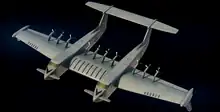
The Liberty Lifter is a concept from the U.S. military's Defense Advanced Research Projects Agency (DARPA) launched in mid-2022 to develop a long-range, low-cost transport using the idea of a maritime ground-effect vehicle not unlike the Soviet-era ekranoplan.
History
DARPA launched the project in mid-2022, wanting a plane that could combine lift of large, heavy loads by skimming the water in ground effect, but also capable of operating at mid-altitudes of up to 10,000 feet. Such a vehicle would also be able to land and take off from the water, making it runway-independent.[1][2]
In February 2023, DARPA awarded contracts to two contractors to develop their own plans. One was General Atomics Aeronautical Systems (GA-ASI), partnering with Maritime Applied Physics Corporation; their design features a twin hull and a mid-wing, powered by twelve turboshaft engines.[3] The other participant was Boeing subsidiary Aurora Flight Sciences partnering with Leidos subsidiary Gibbs & Cox and with ReconCraft; their design is a monohull with a high-wing, primarily relying on eight turbine engines.[4][5]
The initial Phase 1 GA-ASI group contract was for about $8 million for the next six months, with an option for another 12 months potentially growing to a total of $29 million.[3] The Aurora contract was for about $5.6 million.[6]
In July 2023, DARPA exercised options on both teams’ initial proposals, and awarded GA-ASI an additional $21.5 million, and Aurora about $19.5 million, to fund continued development efforts.[6]
Specifications for the craft include the ability to fly less than 100 feet from sea level to harness ground effect, but also the ability to climb as high as 10,000 feet above mean sea level.[7] It should have a ferry range of 6,500 nm,[5] and be able to take off and land in sea state 4, but sustain on-water operations up to sea state 5.[8] And, it should meet the United States Department of Defense heavy lift requirements of 100+ tons.[4] Such a craft would be similar in size and capacity to the Boeing C-17 Globemaster III.[9] DARPA is hoping for all of this with a low-cost design and construction philosophy.[4]
Final designs for Phase 1 are expected by mid-2024.[4] The winning proposal will proceed to Phase 2, which includes further design work, and the building and testing of a full-size prototype,[4] which will then continue to flight-testing within roughly five years.[5]
References
- ↑ "Cargo Hauling Ekranoplan X-Plane is being Developed by DARPA". Thomas Newdick, The Drive, May 19, 2022. Retrieved 2023-05-25.
- ↑ Blain, Loz (2022-05-24). "DARPA Liberty Lifter aims to bring back heavy-lift ground effect seaplanes". New Atlas. Retrieved 2022-05-24.
- 1 2 "GA-ASI Selected by DARPA to Support Liberty Lifter Program". General Atomics, February 1, 2023. Retrieved February 2, 2023.
- 1 2 3 4 5 "DARPA Selects Performer Teams for Liberty Lifter X-Plane Program". www.darpa.mil. Retrieved 2023-05-25.
- 1 2 3 "Aurora Flight Sciences To Design Revolutionary Seaplane for DARPA Liberty Lifter Program". Aurora Flight Sciences. Retrieved February 2, 2023.
- 1 2 "DARPA advances 'Liberty Lifter' seaplane competitors with another $40m in funding". FlightGlobal, July 28, 2023. Retrieved October 10, 2023.
- ↑ "Liberty Lifter". DARPA. Retrieved February 2, 2023.
- ↑ "DARPA Selects Two Teams For Liberty Lifter X-Plane Program". NavalNews, February 1, 2023. Retrieved February 2, 2023.
- ↑ "DARPA Awards Contracts for Long-Range 'Liberty Lifter' Flying Boat Design". USNI News, February 1, 2023. Retrieved February 2, 2023.